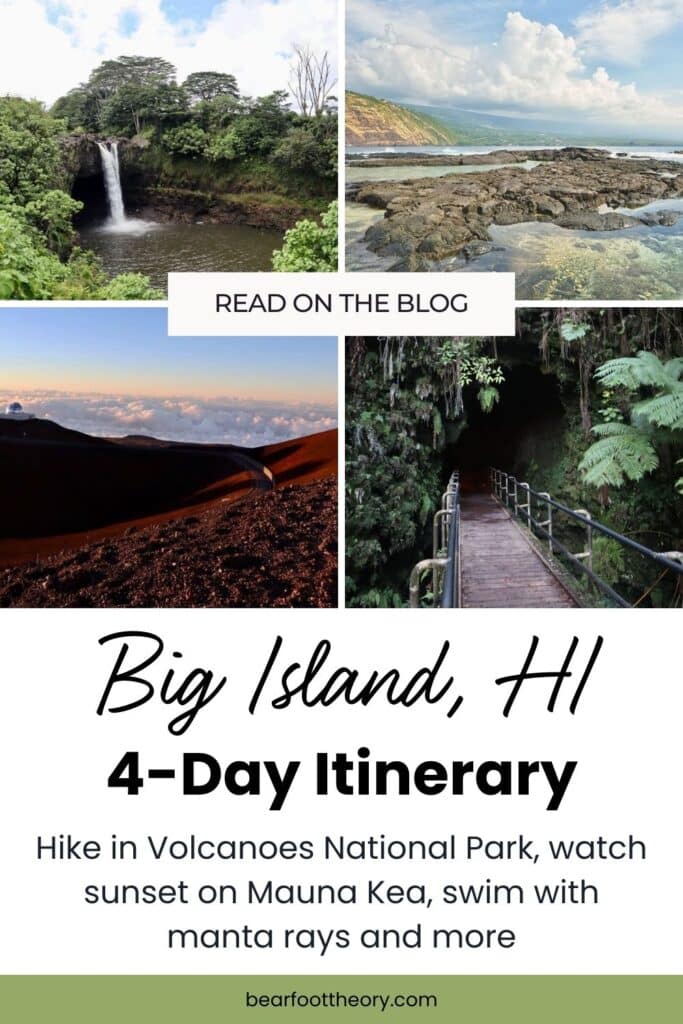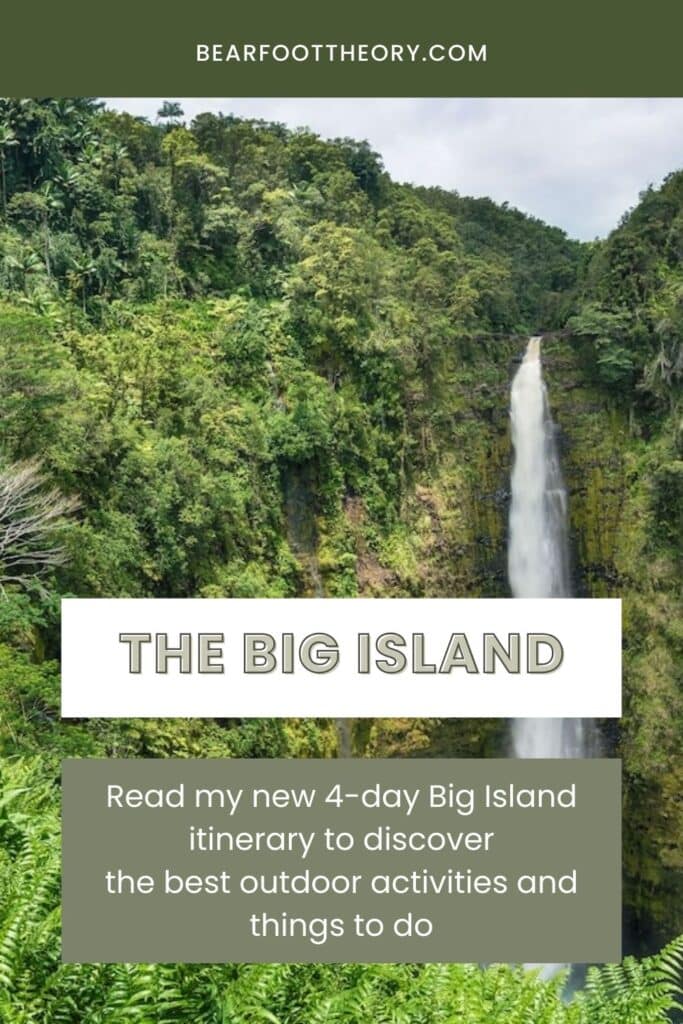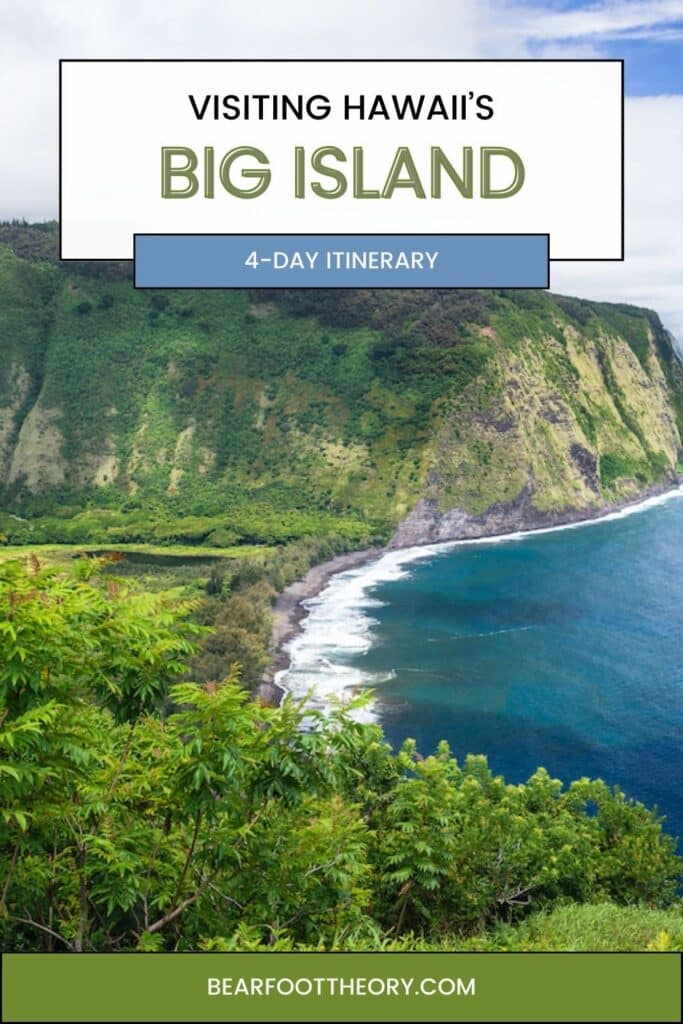4-Day Big Island Itinerary for Outdoor Lovers
Visiting waterfalls, snorkeling, hiking and exploring Volcanoes National Park are just a few things you’ll do on this adventure-packed 4-day Big Island itinerary.

The Big Island of Hawaii certainly has no shortage of incredible outdoor adventures. The island is a paradise for anyone who loves to get out in nature, from exploring lush forests and beautiful beaches to hiking up volcanoes and through lava tubes.
As a frequent traveler to Hawaii, I’ve spent a lot of time exploring the Big Island and know it like the back of my hand. I’ve done many Big Island itineraries and have the scoop on the best places to see, things to do, and how to escape the crowds.
This four-day adventure-packed Big Island itinerary will take you to some of the most spectacular sites on the Big Island including active volcanoes, waterfalls, marine life, and more.
This post may contain affiliate links.
Big Island Itinerary at a Glance
The Big Island is known for its variety of incredible outdoor adventures, so this Big Island itinerary is geared toward visitors who are looking to get outside and explore. Here’s what you will see and do:
Where you will visit
DAY 1: Kealakekua Bay & Mauna Kea
DAY 2: Hawaii Volcanoes National Park
DAY 3: Beach Day & Snorkeling with Manta Rays
DAY 4: Explore Hilo
Save this post!
Enter your email & I'll send this post to your inbox! You'll also receive my weekly newsletter full of helpful advice for planning your adventures.
Day 1: Kealakekua Bay & Mauna Kea
Morning – Snorkeling
Start your Big Island itinerary by spending the day at Kealakekua Bay on the Kona side of the island.
Kealakekua Bay is a protected marine sanctuary and is the best spot for snorkeling on the island.
The bay is home to abundant marine life including spinner dolphins, green sea turtles, and vibrant coral reefs.
Not only is the bay great for snorkeling, but it’s also a place of historical significance. Kealakekua Bay is where Captain James Cook, the renowned British explorer, first set foot on the island in 1778.

There are three ways to get to Kealakekua Bay:
1. Boat tour
The easiest and most popular method for visiting Kealakekua Bay is by taking a boat tour. The great thing about a boat tour is not only will you get to snorkel, but you also get to see the colorful volcanic coastline with sea caves, blow holes, and lava tubes.
Back in 2006, BFT Founder Kristen lived on the Big Island and worked as a deckhand for Captain Zodiac, one of the Big Island’s few certified sustainable tour operators. They are still in business today and offer one of the most exciting boat tours to Kealakakua Bay. On this tour, you’ll be traveling on a 16-passenger fast-moving zodiac raft that can get a lot closer to the coastline than a larger catamaran. The ride can be very bumpy though, so only do this if you’re ready to hold on.
Regardless of what boat tour you choose, most offer snorkels and fins so you don’t have to worry about bringing your own.
2. Kayaking
If you want a more adventurous way to experience the bay, consider renting kayaks and paddling down to Kealakekua Bay from a nearby launch point.
I recommend going with a guided kayaking tour, as permits are necessary for each kayak that enters the bay.
You can also rent a kayak that has a permit and venture out on your own. Kayak rentals are available on the side of Highway 11 and along Route 160, the road that takes you to the bay.
3. Hike the Ka’awaloa Trail
There is a challenging hiking trail down to Kealakekua Bay. The trail is 3.8 miles roundtrip and is quite steep. Kristen did this hike often when she lived on the Big Island and found it to be great for exercise, but I thought the hike back to the trailhead was pretty exhausting after a couple of hours of snorkeling.
However, if you’re looking to combine hiking and snorkeling, this is a great way to spend the day. Get to the trailhead early as parking is limited. The trail travels through grasslands with sweeping ocean views, losing at 1,200 feet as you hike down to the Bay. Just be aware there is hardly any shade on this hike, and you’ll need to bring your own snorkeling gear, reef-safe sunscreen, and plenty of water and snacks. Then give yourself plenty of time to snorkel and for the trek back to your car.
Evening – Mauna Kea
After a day of snorkeling and spending the afternoon relaxing at your hotel, head up to the top of Mauna Kea for sunset.
Mauna Kea is the tallest mountain in the world when measured from its base at the seafloor, and it towers over the Big Island’s beautiful landscape.
The 13,803 foot summit has some of the best stargazing opportunities in the world due to its high elevation and lack of light pollution. The view from Mauna Kea is an unforgettable experience!
A four-wheel-drive vehicle is required past the Visitor Center to the summit. Also, stop by the Visitor Center to acclimate before heading to the summit.
If you don’t feel like driving, there are many tour companies that offer sunset/stargazing tours up to Mauna Kea.
It gets cold at the summit, so bring a warm jacket. If you are lucky, you might even see some snow!

Tip: You don’t have to rent a 4WD during your entire stay on the island. We only rented one for the day we needed it for Mauna Kea and it was well worth the cost. We then returned it for a cheaper car for the remainder of our trip.

Day 2: Hawaii Volcanoes National Park and Punaluʻu Black Sand Beach
Morning – Hawaii Volcanoes National Park
Hawaii Volcanoes National Park is one of the top things to do on this Big Island itinerary. This National Park is home to two active volcanoes, Kīlauea and Mauna Loa. It’s also home to some of the best hiking trails in Hawaii and numerous cultural sites.
I recommend starting your day before sunrise to maximize your time in the park, especially if you are staying on the Kona side of the island.
The scenic drive to the park from Kona takes about 1 hour 45 minutes (or 40 minutes from Hilo).
There are multiple things to do at the park – below is the itinerary we followed during our short visit. If you have more time and are looking for additional hikes, things to do, and camping info, head to Bearfoot Theory’s Hawai’i Volcanoes National Park Adventure Guide.
The first thing you should do when you get to the Park is stop by the Visitors Center. There you can learn about the latest volcanic activity, which may dictate what you’re able to do in the Park.
Here are some ideas for a half day in Volcanoes National Park
- Hike to Sulphur Banks from the Visitor Center to see colorful steam deposits and billowing vapors
- Kīlauea Overlook to observe the magnificent Kīlauea Caldera
- Steam Vents, which are caused by the pressure of the magma below
- Thurston Lava Tube, a 500-year-old lava tube formed when a hot river of lava flowed into solidified rock and cooled.
- Chain of Craters Road
- Kealakomo Overlook for stunning ocean views
- Holei Sea Arch, an impressive lava rock formation.
- Pu’u Loa Petroglyphs & Hiking Trail, a 1.4-mile trail that features over 23,000 petroglyphs

Bonus option: See Kīlauea erupting! If you are lucky enough to visit during an eruption of Kīlauea, we recommend skipping Punaluʻu Black Sand Beach mentioned below and staying at the park until dark to catch a glimpse of the lava flowing.
In recent years, the best places to watch the lava flow have been from Halemaʻumaʻu Crater or Kīlauea Overlook if you can find parking.
Read next: Check out our complete guide to Hawai’i Volcanoes National Park for more things to see and do in the park.

Afternoon – Punaluʻu Black Sand Beach
If you have time after visiting the Hawaii Volcanoes National Park, make your way to Punaluʻu Black Sand Beach, which is located about 19 minutes from the Park.
Often called the “best black sand beach on the Big Island”, Punaluʻu Beach is not to be missed on your Big Island itinerary.
This beach is also home to endangered species such as the Hawaiian green sea turtles, which you’ll often find resting here. Remember to follow guidelines and do not disturb the wildlife.

Day 3 – Beach Day and Night Snorkel with Manta Rays
Morning – Beach Day
Since yesterday was a busy day, today will be a bit more relaxing. This is the perfect day to go to the beach, kick back, and soak up the sun.
We recommend spending the day at Hapuna Beach along the Kohala Coast. This white sand beach is the largest white sand beach on the Big Island and is one of the most beautiful beaches in Hawaii.
Hapuna Beach is excellent for swimming and snorkeling if the waves are calm. Be aware of shore breaks and strong currents, though, and avoid swimming if the waves are high.

If you visit from December to March, you might even see some humpback whales in the distance. We got lucky and saw them breach out of the water while lying on the beach!
Note: There is an entrance fee of $5 per person and parking is $10 per vehicle. Children under three years old enter for free. The parking fee put us off during our first visit here, but it was worth it!
Another option is to spend the day at Kua Bay, a pristine paradise with a white sand beach just north of Kona.
The water is crystal clear and perfect for swimming and snorkeling when the waves are calm.
The beach has no shade, though, so bring a sun shade and reef-safe sunscreen. Parking is free and there is no entrance fee.

Evening – Night Snorkel with Manta Rays
Today you will end your day with an extraordinary experience: snorkeling (or SCUBA Diving) with manta rays in Kona!
Not many places in the world offer this experience, but luckily the Big Island does. This once-in-a-lifetime adventure will take you into the open ocean to watch these majestic creatures feed on plankton under the starry night sky.
Bright lights are illuminated in the area, creating an otherworldly scene as these gentle giants glide gracefully through the water. It’s a surreal encounter that will leave you in awe of the natural wonders that the ocean holds.
If there is one tour you should splurge on during your trip to the Big Island, this is it! We’ve snorkeled with mantas on The Big Island twice and would not hesitate to do it again. The guides are very knowledgeable and respectful and the experience is unforgettable.

We recommend booking with Sea Paradise, Kona Ocean Adventures, or Hawaii Oceanic. We went with Sea Paradise and the experience was amazing. We highly recommend them!
Manta rays are a protected species in Hawaii, so respect their habitat and follow all relevant safety guidelines.
Note: In recent years, swimming with manta rays has become increasingly popular. There are no safety or sustainability best practices in place, which has led Hawaii Ocean Watch to not consider it an eco-friendly activity anymore.
Day 4: Explore Hilo
On the final day of your Big Island itinerary, you’ll explore the city of Hilo. Situated on the eastern side of the Big Island, this charming town is known for its lush rainforests and small-town vibes.
We recommend grabbing breakfast in Kona and venturing to Hilo. While the drive is 1 hour and 30 minutes, it’s scenic and peaceful. I have done this drive numerous times, and it’s always a highlight of my trip!
Here are a few stops and adventures I recommend while visiting Hilo:
Rainbow Falls
Start your day with a visit to Rainbow Falls where you can view an 80-foot-tall waterfall cascading into a pool below.
The waterfall gets its name from the rainbows that often appear in the mist when the sun’s rays hit the water.
The Falls can be easily accessed since it’s located a few steps from the parking lot.
Note: swimming is no longer allowed due to safety reasons. During our last visit, we saw some people attempting to jump into the pool below the falls, but don’t be tempted to do so as it’s extremely dangerous. The signs keep everyone safe and we urge you to respect them.

Akaka Falls
Take a short 6-minute drive from Rainbow Falls to the stunning Akaka Falls State Park.
Here you’ll find two of Hawaii’s most iconic waterfalls: Kahuna and Akaka.
Kahuna is a 100-foot waterfall that tumbles over a sheer cliff face, while Akaka Falls is a powerful 442-foot waterfall that drops into a stream-eroded gorge. Most people usually come here to see Akaka Falls, but since you’re already there, you might as well look at both!
The falls can be accessed via a short and easy 0.4-mile loop trail. The paved route includes multiple steps but is well-maintained and easy to navigate.
Swimming is also not allowed here, but the views from the overlooks are incredible and worth the visit.

Pe’e Pe’e Falls
The last waterfall to visit today is Pe’e Pe’e Falls, located a short 9-minute drive away from Akaka Falls.
This hidden gem is one of the lesser-known waterfalls on the Big Island, but it’s well worth a visit if you are in the area and have some time. These falls are fed by the Wailuku River, which also feeds Rainbow Falls.
Unfortunately, hiking down to the waterfall and pool is no longer permitted due to safety concerns. However, you can still observe a partial view of the waterfall from a lookout point near the parking area.

Kaumana Caves
Before you head back to Kona, make a stop at Kaumana Caves. Located just 6 minutes away from Pe’e Pe’e Falls, the caves are an incredible lava tube cave system and one of the most unique attractions on the Big Island.
The caves were created by a flow of lava from Mauna Loa in 1880 and are part of a 25-mile-long lava tube. Today, visitors can explore the caves and their tunnels extending more than two miles.
Remember to bring a headlamp, good shoes, and plenty of water. The cave might be muddy and slippery in spots, so be careful while exploring.
As a note, there are lots of mosquitos here. I always bring some insect repellent to avoid bites. But don’t let that deter you from visiting! The stunning natural formations in the caves are well worth the minor inconvenience of mosquitos.
These caves are also part of the main reason I go to the Hilo side of the island.

Downtown Hilo for Food
Lastly, grab a bite to eat in downtown Hilo before driving back to Kona. This charming town is full of great restaurants and cafes that offer delicious local and international cuisine. This is always our last stop on our Hilo road trip, and it never disappoints.
For fresh seafood, check out Seaside Restaurant, Moon and Turtle, or Pineapple’s Island Fresh Cuisine. Our top favorite restaurant is Seaside Restaurant – we highly recommend the teriyaki butterfish and the fried aholehole. Both were delicious and cooked to perfection.
If you’re looking for something more casual, head to Jackie Rey’s Ohana Grill, Cafe Pesto, or Ken’s House of Pancakes. If you love breakfast as much as we do, pancakes at Ken’s House of Pancakes are a must-try!
For a quick bite to eat, Hilo Bay Cafe and Hawaiian Style Cafe are our favorites. Hilo Bay Cafe has some of the best views in town and Hawaiian Style Cafe is known for its delicious pancakes, steak and eggs, and vegetarian options.
For a delicious vegan Vietnamese inspired meal, head to the Vegan Shop.
And, of course, a trip to Hilo isn’t complete without a visit to Two Ladies Kitchen for some of the best mochi on the island. While we always have to wait in line, it’s always worth it for their fresh and flavorful mochi.
Getting to the Big Island
The Big Island has two main airports: Kona International Airport to the west and Hilo International Airport to the east.
I flew into the Kona International Airport since most flights arrive there. Kona is also where most visitors stay while exploring the island.
Since the Big Island is “big” (hence the name), renting a car for your stay is best. This will give you the freedom to explore the island and experience all that it has to offer.
Rental cars can be picked up at the Kona airport. You’ll definitely want to book ahead, though.
Big Island Weather
The weather on the Big Island of Hawaii is as diverse as its terrain, creating a unique experience unlike any other island.
Some areas receive no rainfall throughout the year, resulting in dry landscapes, while places like Hilo and Puna are known for consistent rain, making the east side of the island more lush.
The wet weather on the east coast is the main reason most tourists stay in Kona compared to Hilo. Kona has more sunny days, while Hilo gets more rain.
The island maintains a warm tropical climate year-round, with coastal regions averaging temperatures between 75-85°F in the winter and summer. However, higher elevations like Mauna Kea, Waimea, and certain inland areas can be cooler.
The summits of Mauna Kea, Mauna Loa, and Hualālai can be cold since they’re above 10,000 feet high. Be sure to pack warm layers if you plan to journey up any of these mountains.
We’ve visited the Big Island multiple times during the winter and summer months and can attest that the weather is warm and enjoyable all year round.
While it might rain more in the winter, it typically passes quickly, and you can still enjoy the sun for most of the day.
READ NEXT
Planning a trip to Hawaii? Use these posts to make sure you make the most of your time in paradise:
Save this post to Pinterest
What questions do you have about this Big Island itinerary? If you’ve visited, what else would you add? Leave a comment below!






